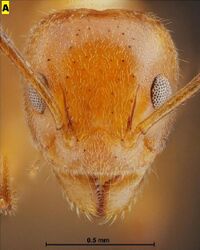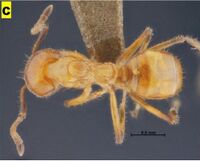Dolichoderus bakhtiari
| Dolichoderus bakhtiari | |
|---|---|

| |
| Scientific classification | |
| Kingdom: | Animalia |
| Phylum: | Arthropoda |
| Class: | Insecta |
| Order: | Hymenoptera |
| Family: | Formicidae |
| Subfamily: | Dolichoderinae |
| Tribe: | Dolichoderini |
| Genus: | Dolichoderus |
| Species: | D. bakhtiari |
| Binomial name | |
| Dolichoderus bakhtiari Barabag & Jaitrong, 2022 | |
The only known collection of this species (the type series) were foraging on leaves of shrub trees in a primary upland evergreen forest at about 800 m a.s.l. in Nakhon Ratchasima Province, Northeastern Thailand.
Identification
Dolichoderus bakhtiari is most similar to Dolichoderus taprobanae in general appearance as they share some common characters like reddish to yellowish body color; head microreticulate with smooth and shiny interspaces; relatively small body size; dorsally flat pronotum; nearly right-angled propodeal junction.
However, D. bakhtiari can be easily separated from D. taprobanae by the following combination of characters:
- body larger in size (TL 3.14–3.63 mm, HL 0.73–0.79 mm, HW 0.6–0.76 mm) vs. body smaller in size (TL 2.51–2.93 mm, HL 0.66–0.69 mm, HW 0.49–0.52 mm) in D. taprobanae
- head slightly longer than broad vs. head slightly shorter than broad
- body entirely yellowish brown vs. vertex of head and gaster dark brown
- dorsal outline of propodeum weakly convex vs. dorsal outline of propodeum straight
- lateral face of pronotum relatively smooth with more developed of frontal carinae vs. lateral face of pronotum punctate with less developed of frontal carinae
Keys including this Species
Distribution
Latitudinal Distribution Pattern
Latitudinal Range: 14.6° to 14.6°.
| North Temperate |
North Subtropical |
Tropical | South Subtropical |
South Temperate |
- Source: Barabag & Jaitrong, 2022
Distribution based on Regional Taxon Lists
Oriental Region: Thailand (type locality).
Distribution based on AntMaps
Distribution based on AntWeb specimens
Check data from AntWeb
Countries Occupied
| Number of countries occupied by this species based on AntWiki Regional Taxon Lists. In general, fewer countries occupied indicates a narrower range, while more countries indicates a more widespread species. |

|
Estimated Abundance
| Relative abundance based on number of AntMaps records per species (this species within the purple bar). Fewer records (to the left) indicates a less abundant/encountered species while more records (to the right) indicates more abundant/encountered species. |

|
Biology
Castes
Nomenclature
The following information is derived from Barry Bolton's Online Catalogue of the Ants of the World.
- bakhtiari. Dolichoderus bakhtiari Barabag & Jaitrong, 2022: 3, figs. 1, 3 (w.) THAILAND.
Unless otherwise noted the text for the remainder of this section is reported from the publication that includes the original description.
Description
Worker
Holotype: TL 3.20, HL 0.79, HW 0.73, EL 0.17, MdL 0.30, SL 0.76, ML 0.96, PL 0.23, PH 0.33, DPW 0.23, CI 92, OI 23, MdI 38, SI 105. Paratypes (n = 10): TL 3.14–3.63, HL 0.73–0.79, HW 0.69–0.76, EL 0.13–0.17, MdL 0.26–0.33, SL 0.69–0.76, ML 0.89–0.99, PL 0.23–0.26, PH 0.26–0.33, DPW 0.20–0.26, CI 91–96, OI 19–23, MdI 35–43, SI 100–105.
(holotype and paratypes): Structure. Head in full-face view, oval, slightly longer than broad (CI 91–96); posterior margin weakly convex and shallowly emarginate medially, lateral margin convex; eye relatively large, located anterior to midlength of head laterally, with 14–15 ommatidia along the longest axis; antennal scape long (SI 100–105), scape extending posteriorly slightly beyond the posterolateral corner of head; pedicel and flagellomeres longer than broad; antennal segment XII almost as long as segments X and XI combined; mandible subtriangular; masticatory margin with sharp apical tooth followed by 11–12 smaller teeth, and basal margin straight with 4–5 small denticles; frontal lobe narrow covering the antennal socket; frontal carina short, reaching half-length of head; clypeus broad, with anterior margin almost straight but feebly concave medially; mesosoma in profile pronotum dorsally flat, mesonotum convex and steeply sloping to metanotal groove; in dorsal view, mesonotum with shallow longitudinal groove; in profile view propodeum weakly convex; propodeal junction right-angled; mesopleuron demarcated from metapleuron by distinct groove, anterior margin of mesopleuron forming sharp triangle; metapleuron not clearly demarcated from lateral face of propodeum; petiole scale-like, convex dorsally and elevated anteriorly, anterior margin shorter than the posterior margin; legs relatively long (compared with other smaller species such as D. taprobanae).
Sculpture. Head entirely superficially reticulate with slightly smooth and shiny interspaces; pronotum mostly punctate but slightly shiny; mesonotum, mesopleuron, and dorsal face of propodeum irregularly rugulose and punctate; metapleuron mostly smooth and shiny; petiole smooth and shiny; gaster superficially reticulated with smooth and shiny interspaces; coxae and femora superficially reticulated with smooth and shiny interspaces; tibiae are finely micropunctate.
Pilosity and coloration. Dorsal surface of head, mesosoma, and gaster covered with dense short white decumbent hairs mixed with dense brown erect hairs; longest erect hair on pronotum about three times as long as erect hairs on gastral tergites; legs with short suberect hairs; entire body yellowish brown with sparse dark spots on the head dorsum.
Type Material
- Holotype worker (THNHM-I-22732, THNHM), NE Thailand, Nakhon Ratchasima Province, Pak Chong District, Moo Sri Subdistrict, 9. II. 2020, W. Khaikaew leg., from a colony (WK090220-01).
- Paratypes: 32 workers (THNHM-I-22733 to THNHM-I-22764), same data as holotype (SKY Collection, Natural History Museum of the National Science Museum).
Etymology
The specific name is dedicated to the late Dr. Bakhtiar Effendi Yahya, who worked on the taxonomy of Malaysian ants between the years 2000-19.


